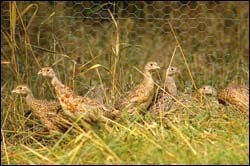How to keep your birds close

Most of our birds go to wood in July, so it?s usually mid-August before they start getting out of the pens and having a wander about. Once they?re flying off roost and landing outside the pen in the mornings, we open the gates and let the rest out. The gates are closed and the electric fences are turned back on in the evenings (once the birds have pulled back to the pen) for about another month. Then we open them up for good.
By the end of August, a fair number will be roosting outside. If they?ve settled in okay, they shouldn?t go too far from the pen during the day, and will probably hang around for another two or three weeks before they begin to spread out and start heading for the boundary. Our job is to try to delay the wandering.
As the birds get out of the pen, we move some of the feeders out with them. We also trail and scatter food on the rides next to the pens. This reduces competition at the feeders and helps keep the birds occupied. The automatic drinkers are gradually moved out with the feeders and we put a few manual ones where the autos won?t reach. Clean drinking water is essential; if they can?t find water, they?ll go and look for it. Grit is important, too. There?s a school of thought that says the birds will wander off looking for grit, as well. I?m not so sure about this but we do provide it ? they need it in their gizzards. The grit in a gizzard acts as a bird?s teeth; it helps break up the food and makesit easier to digest. We put a 25kg bag of grower size ?granite? grit out for every 800 to 1,000 poults we release, and as it always gets used, they must need it.
Putting straw down for birds to scratch about in used to be more popular than it is now. When I started keepering, all the feed rides were ?strawed down?, then the pellets (or wheat) were scattered on top. It made the birds work for their food and the poults did seem to hang about pecking at it ? but only while the straw was fresh. Once it got wet, they lost interest.
If you can get hold of some straw it?s worth doing, but finding small bales you can handle might prove difficult. The big ones are okay but you?ll either need someone with a tractor who can drop them off or a trailer with a drop-down tailboard, so you can roll them up one at a time. We still use them if we?re given a broken one off the field which we can load into the back of the truck in bits. It?s then a simple matter of unloading it as close to the pen as we can get and scattering some food on top. The poults like it and it helps keep them busy and close to home.
Dog-walker danger
The other thing pheasants need if they are going to hold well is peace and quiet. If they keep getting pushed about by dog-walkers or disturbed by forestry operations, they?ll leave the area around the pens before they?re properly homed in. If they move too far, too quickly, they will get lost and it can be a real struggle to get them back.
Having decent cover in the woods and a few strategically placed gamecrops for them to hide in if they feel harassed will help, but the real key to keeping them settled is to reduce the amount of disturbance in the first place.
Most dog-walkers stay on the paths and have set routes; sadly, there are others who feel they have some sort of ?grandfather?s right? to wander where they want. We have signs in the worst spots, asking them to keep to the public footpaths and to keep their dogs on leads. The vast majority do as they?re asked, but the only way to deal with the awkward ones is to go up to them the moment you see them and tell them, politely, to head back to the path, point out any signs and the correct route, and (if they give you a chance) explain why they need to keep to the paths in the first place.
If word gets round that certain areas are out of bounds and that the keeper is putting people back on the paths, it becomes less of a problem.
Forestry disruption
Forestry operations, especially felling and forwarding, can be hugely disruptive if they?re carried out near the release areas at the wrong time of year (something which isn?t always appreciated by the buyers and contractors). The noise and disruption will unsettle the poults, and if they?re unsettled, they?ll move.
Fortunately for us, our woodland is managed in-house. My employer and I discuss the felling and replanting programmes when we have our end of season meeting and we rarely have any problems. It?s more difficult if the forestry?s managed by someone who doesn?t have a vested interest in the shoot. But a spring meeting or yearly discussion, where you can voice your concerns or help come up with a five-year plan, will make things a lot easier.
There?s always going to be some disruption, because woods need to be managed, but if it?s timed right and the sensitive areas are avoided once the birds go to wood, it makes it a lot easier.
Making sure that your birds have plenty of food and water, providing them with something to keep them amused, and seeing they don?t get disturbed, won?t keep them at home for ever, but it might just hold them a bit longer. And anything that could reduce the dogging-in is definitely worth a try.








